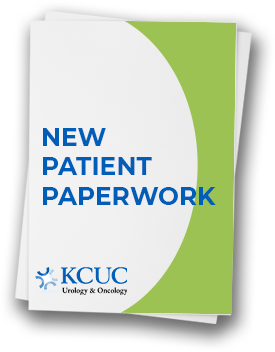With over 20 urologist office locations in Kansas and Missouri, KCUC proudly offers percutaneous kidney stone treatments & procedures in Kansas City, Overland Park, Emporia, Leavenworth, Olathe, Independence, MO, and the entire KC metro area.
What is percutaneous stone removal?
This is a surgical procedure in which stone material is removed directly from a patient’s kidney. In this procedure, the surgeon inserts a scope through a small tube that has been placed directly into the kidney under X-ray guidance. Through this scope, a multitude of instruments can be used to fragment the kidney stone and remove it.
What is the purpose of percutaneous stone removal?
This surgery is most often used for patients who develop large or complex kidney stones that cannot be effectively removed with less invasive techniques like ureteroscopy or shock wave lithotripsy (ESWL). This treatment decision is most often influenced by the total stone size, but can also be determined by the composition of the stone material, as well as patient factors such as overall health and body habitus.
This procedure is performed in the operating room with the patient under general anesthesia. There are two stages in the procedure. The first stage involves placing a needle and then a wire through the skin into the kidney. This is performed with the help of x-ray equipment and may be performed in the hospital radiology department ahead of time or at the time of surgery in the operating room. The second step of the procedure is placement of a surgical tube over the wire into the kidney to allow access for the surgeon to place his endoscope and subsequently break apart stone material and remove it.
Following the surgery or Percutaneous Nephrolithotomy, the patient generally has a drainage tube that is placed through the flank region into the kidney, as well as a catheter inserted through the urethra into the bladder. Patients typically stay in the hospital 1-3 days after this surgery.
What are common symptoms following my percutaneous stone removal?
The most commonly reported symptom following this procedure is pain at the incision site. Even though a small incision is used in this procedure, the flank area is very sensitive, and may patients may experience discomfort for several days following the surgery. By the time you leave the hospital, however, you will be comfortable with the help of oral pain medication.
Blood in the urine is also very common following the surgery and may intermittently occur for several weeks following the surgery. This is usually a small volume of blood and will not require treatment or blood transfusion.
When should I contact my physician?
You should contact your physician any time that you develop a persistent fever greater than 101 degrees Fahrenheit or if you develop severe flank pain or abdominal pain that is not improved with the pain medication that you are given. If you develop significant blood in the urine, then you should also contact your physician. This would be denoted by passage of urine that is the consistency of ketchup or associated with clots greater than silver dollar size.

